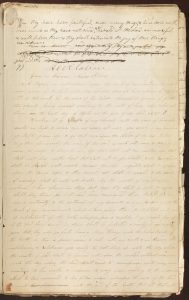Historical Context and Background of D&C 1

Video Overview
Brief Synopsis by Steven C. Harper
The Doctrine and Covenants is a problem solver. Every section in it resolves a problem or a dilemma. Joseph Smith learned as a youth that when he had a dilemma he could not resolve, he could ask God in faith and be answered, not upbraided (Joseph Smith—History, 1:10–19).
In the case of Doctrine and Covenants section 1, the problem was how to preface the Book of Commandments. By November 1831, Joseph had dictated dozens of revelation texts. John Whitmer had hand-copied many of them into the Book of Commandments and Revelations. The missionaries and their converts needed copies, so Joseph gathered a group of elders at the Johnson home in Hiram, Ohio, and together they determined to publish the revelations in a book: the Book of Commandments.
Every book needs a preface to guide readers and tell them what the author intends. A committee of the Church’s best writers drafted a preface for the book, but it was not suited to the task of introducing the Lord’s latter-day revelations. The Lord then revealed what he called “my preface to the book of my commandments” (D&C 1:6, emphasis added). Joseph sat down near a window and dictated the words slowly as Sidney Rigdon wrote them down.1
What does section 1 say about what the Savior intends to accomplish by giving the latter-day revelations? It tells why the Lord opened the last dispensation. He saw the consequences of broken covenants. People had “strayed from [His] ordinances” (D&C 1:15), gone off in their “own way” (v. 16), and created their own gods. Calamitous judgments were therefore inevitable and imminent. Knowing all that, the Lord desired to spare as many people as possible by inviting all to repent and return to him. He called and authorized Joseph Smith and others “that mine everlasting covenant might be established” (v. 22), the living Church of Jesus Christ restored, and His gospel taken to all people everywhere.
In Section 1 the Lord applies the ancient archetype for wickedness—Babylon—to the world of Joseph Smith and the earliest Saints. The Savior’s restored Church is the vehicle out of Babylon. The Lord is pleased with His Church and its mission, which is not the same as being pleased with its members.
Section 1 was not the Lord’s first revelation to Joseph. It belongs at the beginning of the Doctrine and Covenants because it outlines the Lord’s purposes for all the subsequent sections. When Joseph finished dictating and Sidney Rigdon finished writing, the problem was solved—the Book of Commandments now had a preface that was equal to the task of introducing the Lord’s latter-day revelations.
1. “Minutes, 1–2 November 1831,” p. 15, The Joseph Smith Papers, accessed July 21, 2020. “Revelation Book 1,” p. 125, The Joseph Smith Papers, accessed July 21, 2020. Joseph “dictated by the spirit the preface found in the Book of Doctrine and Covenants while sitting by a window in the room. Sidney Rigdon wrote it down. Joseph would deliver a few sentences and Sidney would write them down, then read them aloud, and if correct, then Joseph would proceed and deliver more, and by this process the preface was given.”
Additional Context by Casey Paul Griffiths
From Doctrine and Covenants Minute
Doctrine and Covenants 1 was received on November 1, 1831, at a conference of elders held in Hiram, Ohio, to consider the publication of Joseph Smith’s revelations. According to William E. McLellin, a participant at the conference, a committee consisting of Sidney Rigdon, Oliver Cowdery, and McLellin was initially asked to write the preface to the “Book of Commandments,” as the new scripture was to be called. However, after the conference rejected the preface (according to McLellin, they “picked it all to pieces”), the elders asked Joseph Smith to petition the Lord for a revelation to serve as the preface. Joseph bowed in prayer and dictated the revelation by the power of the Holy Ghost. According to McLellin, “Joseph would deliver a few sentences and Sydney would write them down . . . then read them aloud if correct, then Joseph would proceed and deliver more” until the revelation was recorded in its final form.
While the Doctrine and Covenants is generally arranged chronologically, section 1 is not the first revelation. This section was received in between the revelations now designated as section 68 (which is also out of chronological order) and the revelation designated as section 67. A quick review of these sections, along with the testimony of the elders attending the conference, is useful for context. The elders at the conference (which included future Apostles Orson Hyde, Luke Johnson, Lyman Johnson, Parley P. Pratt, and Lyman Wight) signed a document bearing witness that “these commandments are given by inspiration of God & are profitable for all men.”
See Historical Introduction, “Revelation, 1 November 1831–B [D&C 1],” p. 125, The Joseph Smith Papers, josephsmithpapers.org/paper-summary/revelation-1-november-1831-b-dc-1/1.
See also “Testimony, circa 2 November 1831,” p. 121, The Joseph Smith Papers, josephsmithpapers.org/paper-summary/testimony-circa-2-november-1831/1.
